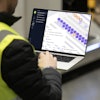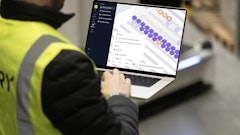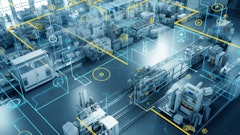
U.S. manufacturers are navigating a volatile landscape shaped by tariffs, inflation, supply chain shocks, and a deepening labor crisis. In response, they’re having to rethink how they operate, turning to technology, not just to boost productivity, but to future-proof their workforce.
New research from Hexagon Manufacturing Intelligence reveals just how central technology has become: 96% of manufacturers believe it will significantly transform their operations within the next five years. When asked what they expect from these investments, time savings came out on top, followed closely by ease of integration and cost efficiency. But just as importantly, manufacturers view technology as a solution to the labor shortage.
While fears of automation replacing jobs still grab headlines, manufacturers told a different story. Nearly two-thirds (65%) of manufacturers believe AI will help them maintain or grow their workforce, and only 18% expect headcount reductions. For most, AI is seen as a tool to empower teams, improving efficiency, speeding up training, and making expert knowledge more accessible across the organization.
With nearly half a million manufacturing jobs currently unfilled and predictions pointing to an almost 1.9 million job shortfall by 2033, companies are under pressure to do more with the teams they have. However, 72% of manufacturers feel outdated technology is actively hurting their ability to attract and retain talent. In this context, modern tools aren’t just about productivity; they’re about creating the next generation of workers.
From AI-driven programming to digital inspection and connected workflows, the technologies gaining traction today in the supply chain are not only optimizing operations—they’re giving talent the modern tools they are looking for. In an environment defined by disruption, these technologies are also reshaping what speed and flexibility look like on the modern shop floor. Here are some of the trending technologies leading that shift.
AI-powered programming is reducing bottlenecks
Despite growing investments in automation, many shops still face delays during the programming phase. This is especially common in high-mix, low-volume environments where manual computer-aided manufacturing (CAM) remains a bottleneck.
Emerging AI-powered CAM platforms are addressing this by learning from past production history, recommending optimal toolpaths, and automating complex decisions that once required expertise from long-employed workers. Research found that these automated systems can reduce programming time by up to 75%, helping manufacturers accelerate production without overloading limited staff.
Rather than relying on static rules, modern platforms continuously evolve with use, refining recommendations over time and scaling institutional expertise. This makes expert-level decision-making accessible across teams and again helps preserve critical shop-floor knowledge. For manufacturers getting started, the key is to begin small, applying AI where bottlenecks are most severe and letting the system learn as it goes.
AI paired with additive manufacturing speed prototypes to production
Additive manufacturing (AM) is also gaining traction as a strategic response to supply chain unpredictability. No longer limited to just prototyping, AM is increasingly used to support production continuity, for instance, in reshoring strategies. With 31% of manufacturers saying they would expand reshoring efforts if tariffs increase, AM offers a flexible way to reduce dependence on third-party suppliers, shorten lead times, and bring critical capabilities in-house.
For manufacturers looking to implement AM, the path forward doesn’t require a full-scale transformation. Many are starting with hard-to-source or high-mix, low-volume parts such as legacy spares, jigs, or custom tooling. When paired with AI and digital workflows, AM can quickly shift from an experimental tool to a core strategy for operational control.
Connected workflows are powering leaner operations
Another growing trend is the adoption of connected worker platforms and digital workflows. For many manufacturers, especially small to mid-sized operations, digital transformation begins not with automation, but with better communication. Traditional tools like clipboards, whiteboards, and manual logs still dominate many shop floors, creating inefficiencies and information silos. Manual, paper-based processes remain a significant barrier in manufacturing, with 31% of organizations reporting that too many analogue workflows slow progress and innovation. Rigid, disconnected processes limit agility and responsiveness, reinforcing the hidden costs of manual workflows in today’s competitive environment.
Cloud-based systems are helping centralize data from design to inspection, giving teams live visibility into shift changes, production status, and maintenance needs. These tools are often implemented without “rip and replace” disruptions, allowing manufacturers to digitize existing infrastructure and gain immediate returns.
These connected systems also lay the foundation for more advanced tools like AI-driven quality systems. When paired with cloud-based workflows, AI solutions can capture and share inspection knowledge across roles, machines, and shifts, reducing reliance on individual expertise and enabling more consistent, scalable performance. For manufacturers working with small teams and growing complexity, that kind of knowledge-sharing infrastructure is a strategic edge.
The best place for manufacturers to start is to use what’s already on hand. Many manufacturers begin by digitizing simple but critical information, like shift notes, inspection logs, or setup sheets. Turning this collective knowledge into a shared digital resource not only improves day-to-day operations but also creates the foundation for other AI-driven capabilities in the future.
AI-driven quality systems are closing the skills gap
As connected, cloud-based workflows become more common, manufacturers are also turning to AI-guided quality systems to address skills gaps on the shop floor. These tools standardize inspection logic, automate CMM programming, and help ensure compliance with ISO/ASME standards, all without requiring extensive retraining or specialized expertise.
The result is faster onboarding, more consistent inspections, and greater confidence in first-pass quality. These solutions don’t replace skilled talent—they extend it, making expert knowledge available across teams and shifts. As workforce shortages continue to strain operations, AI-driven quality systems are becoming a practical path to precision, scalability, and resilience.
Manufacturing resilience will be built on smart systems
Our research findings make it clear: Manufacturers don’t just see technology like AI as transformative, but as essential to building the future workforce. Technology isn’t just improving operations—it’s helping manufacturers prepare for what’s next, even as uncertainty continues to cast a shadow over the industry.
While labor shortages and supply chain complexity remain significant hurdles, manufacturers that adopt smart, adaptable systems are better positioned to respond to disruption.













![Pros To Know 2026 [color]](https://img.sdcexec.com/mindful/acbm/workspaces/default/uploads/2025/08/prostoknow-2026-color.mduFvhpgMk.png?ar=16%3A9&auto=format%2Ccompress&bg=fff&fill-color=fff&fit=fill&h=135&q=70&w=240)



